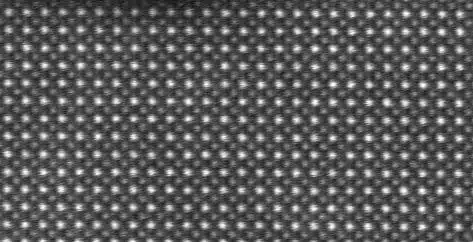The surface of the strontium titanate crystal produces electricity when heated. This surprising property may also be discovered in other materials and used to create new electronic applications

Shiny crystals, once used to fake diamonds, have recently been discovered to have a split personality. The scientists of the Weizmann Institute of Science discovered that the surface of the strontium titanate crystal differs from the interior of the crystal in a fundamental way that was not known until now. "It was discovered that the surface of the crystal behaves as a separate substance", it was written about this discovery in the news and opinions section of the scientific journal Nature.
Strontium titanate crystals are currently mainly used as a substrate for growing a variety of advanced electronic materials. It is known that these crystals are non-polar, but the institute's scientists discovered that a very thin layer on their surface is pyroelectric - that is, it produces electricity when heated - and this means that this layer is polar. Since polarity affects the properties of the material, the "split personality" of the crystal must be recognized when making devices containing strontium titanate. Moreover, the finding has a wider meaning: polarity may also be found in the surface of other inorganic crystals.
"The polarity of the surface in an inorganic material is a new concept", says the head of the research group Prof. Igor Lubomirsky from the Department of Materials and Surfaces. "No one has looked for it so far because it is apparently counterintuitive."
A few years ago, Prof. Lubomirski and his department colleague Prof. Meir Lahav showed that polarity dependent on warming can form on the surface of non-polar organic crystals, such as certain amino acids. But inorganic crystals are characterized by a more rigid symmetry than organic crystals, so it seems that the chances of finding polarity in them - which requires symmetry breaking, for example, through distortions in the structure of the material - are not high. However, Prof. Lubomirski and Prof. Lahav hypothesized that even in inorganic crystals the symmetry is broken - not in the interior of the crystal, of course, but on the surface - so perhaps, against all odds, polarity also exists in non-polar inorganic crystals.
In order to test this hypothesis, the scientists had to show that if and when they discover polarity in an inorganic crystal, its origin is indeed on the surface of the crystal, and not in the interior of the crystal - a task that represents a huge technological challenge. Dr. Elena Mirzada, then a research student, and other group members used for this purpose a unique instrument developed in Prof. Lubomirsky's laboratory, which makes it possible to measure very weak electric currents in time frames of several microseconds (millionths of a second). The scientists heated the surface of the strontium titanate crystals with a laser beam of rapidly varying intensity and measured the resulting electric current. As recently reported in the scientific journal Advanced Materials, they discovered that a current does form, but it quickly fades away - a fact indicating that the current appears only in the topmost layer consisting of individual atoms, about 1 nanometer (one billionth of a meter) thick.
The experimental system that enabled the discovery of pyroelectricity on the surface of strontium titanate crystals
To rule out the possibility that the current was created inside the crystal, the scientists conducted additional experiments. Among other things, they coated the crystals with a very thin layer of silica and found that the pyroelectricity disappeared - a finding that supports that it is a phenomenon of the surface only.
Prof. Lubomirski and his colleagues conducted a theoretical analysis of the findings and concluded that the pyroelectricity was created as a result of a common deformation called "surface relaxation". Since this relaxation is present in many crystals, the scientists believe that surface pyroelectricity may be detected in many different materials. They propose to take advantage of this phenomenon to design devices with many layers, which will make it possible to use the different polarities of the layers to create desired properties for new applications in the electronics, nanotechnology and energy industries.
Furthermore, it is possible that the discovery is bound to hold more surprises: in an opinion article in Nature that analyzed the research, it was hypothesized that although strontium titanate is an insulating material, it is possible that its surface is actually a polar metal - an exotic material expected to have special electronic properties. Many research groups are looking for polar metals, but according to the journal, it is possible that "they have been under our noses all along and that they are found, paradoxically, on the surface of non-polar insulators".
Evgeny McGonn and Dr. David Ahara from the Department of Materials and Surfaces of the Institute participated in the study; Dr. Hagai Cohen and Dr. Irit Goldian from the Department of Chemical Research Infrastructures of the Institute; Dr. Dennis Kristensen, Dr. Argia Baumik, Dr. Juan Maria Lastra and Prof. Nini Frieds from the Technical University of Denmark; Prof. Ari Morales of Stone Hall University; and Prof. Andrew Rapp of the University of Pennsylvania.
The institute's scientists measured an electric current of about 12-10 or 0.000000000001 amperes - ten billion times less than what a standard AA battery produces.
More of the topic in Hayadan:

2 תגובות
very interesting. It does sound like a direction for completely new technological developments.
Note to the editor: From the title, it seems to me that you did not emphasize the meaning of the discovery: it is not a disorder but one of the aspects of the systematic variation between the interior of an ordered substance and the edge of such a substance, close to the place where the regularity ceases. The title "Life on the Edge" might have been more appropriate.
Can I get a link to the article?